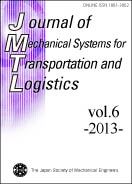Volume 6, Issue 1
Displaying 1-7 of 7 articles from this issue
- |<
- <
- 1
- >
- >|
Papers
-
2012 Volume 6 Issue 1 Pages 1-14
Published: 2012
Released on J-STAGE: January 16, 2013
Download PDF (939K) -
2012 Volume 6 Issue 1 Pages 15-24
Published: 2012
Released on J-STAGE: February 22, 2013
Download PDF (2665K) -
2012 Volume 6 Issue 1 Pages 25-40
Published: 2012
Released on J-STAGE: May 08, 2013
Download PDF (668K) -
2013 Volume 6 Issue 1 Pages 41-53
Published: 2013
Released on J-STAGE: June 25, 2013
Download PDF (584K) -
2013 Volume 6 Issue 1 Pages 54-64
Published: 2013
Released on J-STAGE: June 25, 2013
Download PDF (1281K) -
2013 Volume 6 Issue 1 Pages 65-72
Published: 2013
Released on J-STAGE: August 07, 2013
Download PDF (2333K) -
2013 Volume 6 Issue 1 Pages 73-88
Published: 2013
Released on J-STAGE: August 27, 2013
Download PDF (969K)
- |<
- <
- 1
- >
- >|
